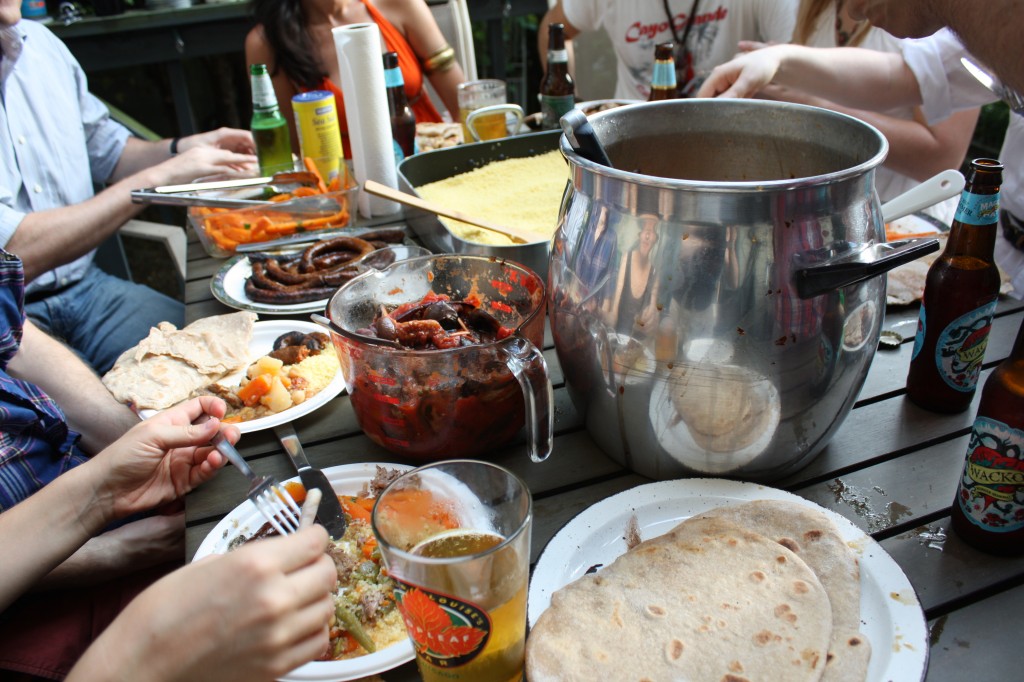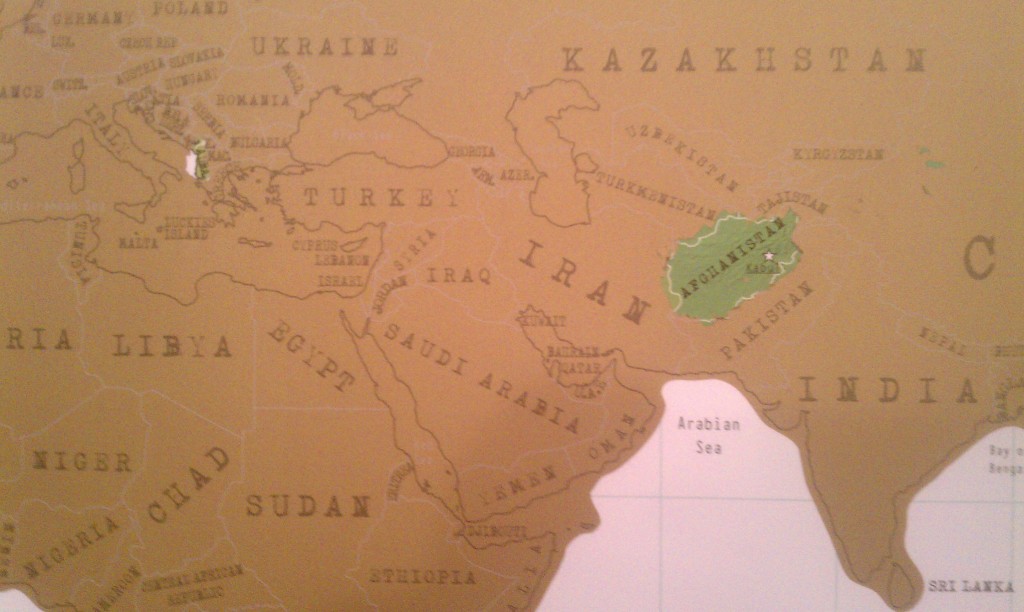
A nation's food is quite often a reflection of its geographic and historical circumstances. In Albania's case, it's across the Adriatic from Italy, not far from Greece, and was a part of the Ottoman Empire for centuries. Hence: yogurt, peppers, lamb, and a hell of a lot of olive oil. (See the shopping list, which doesn't include the gallon of olive oil I bought later.) But of course, each country adds its own twist. In the case of Albania, it's egg. Of course, almost every culture makes use of eggs. But I've never seen a cuisine that puts a little bit in almost every dish!
Our guide for the evening was Rudina, a radio producer from UNICEF from the north of Albania. (Thanks also to Elton and Quinn who sent their advice!) We met her through Snezan, the agent who found us our amazing apartment, and his girlfriend Neely. Rudina gave me a bunch of suggestions of what to cook, and the recipes that went with them. Along with the three of them, we had my college roommate Jeff, his girlfriend Elly, another college friend Sarah-Doe, and Laura's coworker Kirsty.
There were six dishes in the meal, four of which were oven-baked and three of which were fried in olive oil. (Huge thanks to Kirsty for helping with chopping, frying, and much more.) For those of you doing the math, that means that one dish was indeed fried and then baked. It required some gymnastics to do it all on the small range, but it all turned out quite well. Most of the dishes came from Rudina directly; she's graciously allowed me to include them at the bottom of this post.
Rakia | Grape brandy

The Turkish national drink is Rakı, a potent licorice firewater which gives me an instant headache. Given the similarity of the word, I was a bit scared when Rudina brought a bottle of Rakia. But contrary to my assumption, it wasn't licorice-flavored at all, but rather a nice grape brandy.
Fergese | Fried peppers with tomato-feta sauce | Recipe below
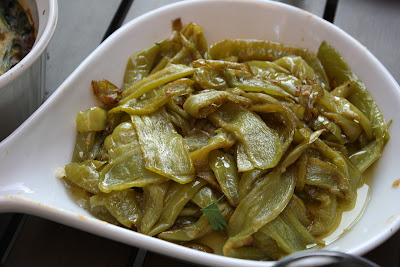
The recipe calls for 1.5 cups of oil. Eek! But yum. The same oil that fried the peppers is the foundation of the sauce with tomato and feta (and a little egg). Pour the sauce on top of the peppers, eat it with a chunk of bread, and you have a deliciously self-contained dish.
Tarator | Fried zucchini with cucumber-garlic yogurt dip

This one is so simple I don't need to give a separate recipe. Just peel and slice zucchini lengthwise and fry it. Pour on a sauce of yogurt with some chopped cucumbers and minced garlic. Done. Yum. These zucchini came from the local farmer's market this morning, and were so fresh they still had that little fuzz on the skin.
Musaka | Spinach and egg casserole | Recipe below
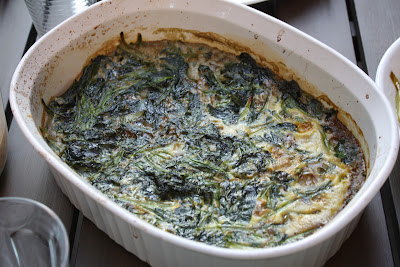
I know the word from Greek food, as an eggplant dish. So what a surprise to see this one based on spinach. Really simple, really good.
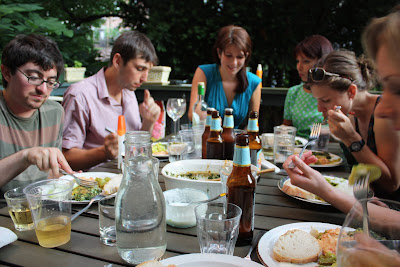
And that was just the first course. Here's the mains.
Byrek me spinaq | Spinach pie | Recipe (scroll down to find it)
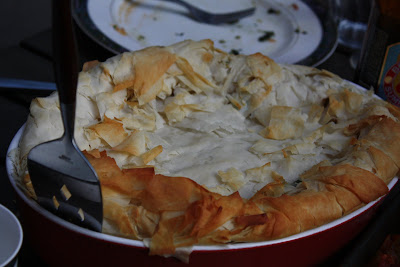
I'm only a slight bit ashamed I didn't make the filo dough. It was effort enough even using pre-made sheets. Did this one have egg too, you ask? Yep, mixed in with the spinach. Baked it most of the way earlier on, then finished it off right before serving. Could have baked it a bit more to make it even crispier, but the filling was great.
Stuffed eggplant | Recipe below
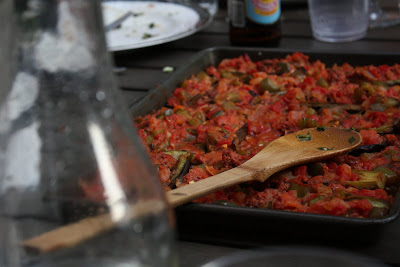
Ta-da! This is the one that was first fried, then baked. The eggplant was lovely and tender, and the filling a nice balance of veggies and meat.
Tavë Kosi | Lamb casserole with rice and yogurt sauce | Recipe below

Despite appearances, I am pretty sure I'll be making this one again. I had never poured dry rice into a pan of roasting meat, let alone an entire quart of yogurt (with — you guessed it! — a bit of egg). Took a while to all set and get the nice crust on top, but worth the wait. Creamy and meaty, but not heavy.
Rudina didn't give any advice about dessert. When I told her I had an ice-cream machine, she advised that I make anything that Italians would eat, "not oreo or cookie or something." I saw the most beautiful cherries in the market, and I knew what I had to do.
Cherry sorbetto | Recipe

When Rudina saw it, she said I couldn't have done anything more appropriate. Apparently, cherries are a popular fruit in Albania. Yes for guesswork! It was so good too. Elly had the genius idea of pouring a bit of rakia over the sorbet to give it a kick, and by the time dessert was over, the entire bottle of 50% alcohol rakia was gone.
As we lingered over dessert, Rudina told some stories about Albania: how folklore has it that rakia cures just about any disease; how the entire country fell into a pyramid scheme in 1997; and how the house she grew up in is 2,500 years old, older even than the Albanian language. I bet that even back then, they were putting a few eggs into whatever they were cooking.
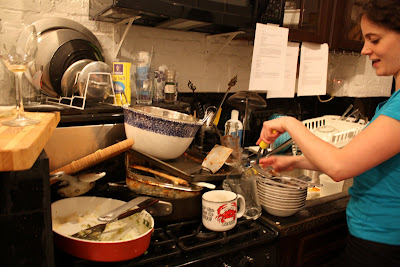
As promised, some recipes from Rudina.
Fergese
• 10 italian frying peppers, seeds removed, cut into strips
• 1-1/2 cups olive oil
• 4-5 big, ripe tomatoes, peeled and cut into small pieces
• 1 tablespoon flour
• 2 eggs
• 4-5 cloves garlic, minced
• 1/4 lb feta cheese, cut into small pieces
• chili pepper (optional)
• crusty bread
Fry peppers in olive oil until soft and brown. Remove them from the pan and place on a plate to cool off. Pour off about a half-cup of the oil and saute tomatoes and garlic slowly until it thickens a bit. While sauteing, beat eggs with flour. Add chili (if using) and cheese. Cook for few more seconds, than add the egg mixture. Cook for 1 minute until the sauce looks thick. The red sauce is put in the middle of the plate and the idea is to deep the peppers to it.
Musaka
• 1 shallot, minced
• 1 kg (a bit over 2 pounds) fresh spinach, cleaned and cut
• 5 eggs, beaten
• some olive oil, salt and seasonings
Heat oven to 450 degrees. In a large pan, saute the shallots, than add spinach, salt and spices. Cook until the spinach is wilted and some of the water boils off. Put a baking pan in the oven a few minutes before the spinach is ready. Move spinach into baking dish, pour eggs on top, bake for 30-35 minutes.
Filled Eggplants
• 6 pieces of eggplants (smaller the better)
• 2 onions
• 250 gr minced meat
• 3 tomatoes
• 1 small can of good tomato sauce
• 5-6 cloves garlic, peeled but not minced
• 2-3 green peppers
• parsley
• black pepper
• paprika
• salt
Clean eggplant by removing the tip end. Peel in stripes, dark stripe – white stripe. Cut the eggplants in the middle and scoop out the bitter inside. Put them in salted water for 45 min. After drying the eggplants with a paper towel, fry them in olive oil. Remove the eggplants and fry the garlic, onion, minced meat, tomatoes and peppers, and add parsley, spices and salt.When done, fill the eggplants and lay them in a oiled baking pan. Add the canned tomato sauce and a glass of water. Bake in the oven for about 10-15 minutes.
Tavë Kosi
• 1 kg of good quality lamb
• olive oil
• salt
• pepper
• 1 liter (4 cups) of fatty yogurt, the fattiest you can get
• 2 eggs
• little rice (a handful, I used about a half tup)
• 2 tbs flour
Cut the meat in five or six pieces. (Note: I used lamb stew meat and it turned out great.) Put it in the baking pan with some olive oil, salt, pepper and bake in miedum heat (I did 350 degrees). Just before the meat is ready, add rice with ½ glass of hot water. Mix the rice into the juices and let it cook. In a bowl mix yogurt, eggs and flour. When rice is done, add the yogurt sauce slowly, stirring it in so it doesn't shock. Put it back in the oven for another 10-15 mins until the top begins to firm up, then remove and serve.
 Published in 1964 by the United Nations Association of the United States of America, it features recipes from the member states of the time, which numbered 114. The foreword suggests that you use the recipes to aid a celebration of United Nations Day, which apparently was a thing that some people cared about back then. In a great nod to the culinary concerns of the time, the book stresses that each of the recipes were verified by at least one of America's most prominent corporate test kitchens. The recipes themselves look surprisingly adventurous relative to my conceptions of the average American's palate, although certain ingredient choices or omissions belie a lack of variety in American soupermarkets, such as soy sauce instead of fish sauce in a Thai soup. (But who am I to judge: the "Thai chicken wrap" I'm about to tuck into on this airplane is no further to authentic!)
Published in 1964 by the United Nations Association of the United States of America, it features recipes from the member states of the time, which numbered 114. The foreword suggests that you use the recipes to aid a celebration of United Nations Day, which apparently was a thing that some people cared about back then. In a great nod to the culinary concerns of the time, the book stresses that each of the recipes were verified by at least one of America's most prominent corporate test kitchens. The recipes themselves look surprisingly adventurous relative to my conceptions of the average American's palate, although certain ingredient choices or omissions belie a lack of variety in American soupermarkets, such as soy sauce instead of fish sauce in a Thai soup. (But who am I to judge: the "Thai chicken wrap" I'm about to tuck into on this airplane is no further to authentic!)
